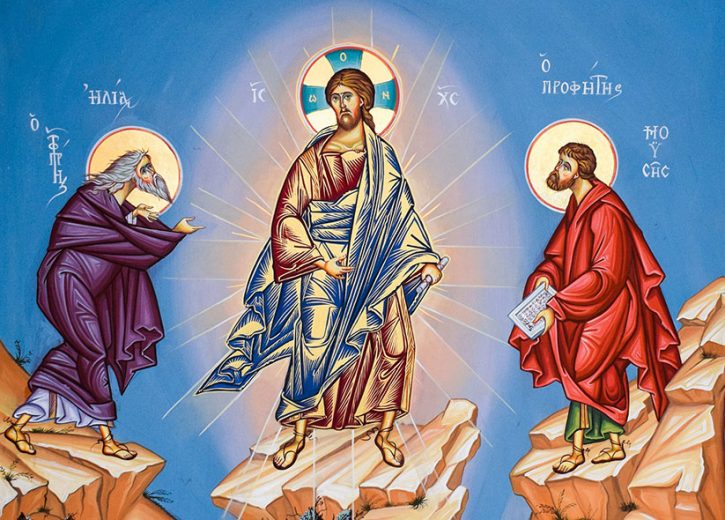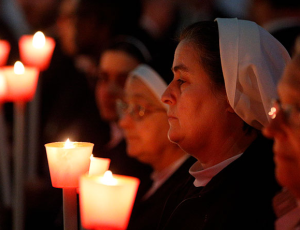from Bishop David M. O’Connell, C.M.
The Feast of the Transfiguration of Jesus is celebrated on August 6. It lifts up for our prayerful consideration as Catholics a pivotal moment in the life of the Lord Jesus. The Gospel of Matthew (17: 1-8), Mark (9:2-8) and Luke (9:28-36) provide details of the event. This year, the Church uses the account of St. Matthew for the Gospel of the Mass for the feast:
Jesus took Peter, James and his brother, John, and led them up a high mountain by themselves.
And he was transfigured before them; his face shone like the sun and his clothes became white as light. And behold, Moses and Elijah appeared to them, conversing with him.
Then Peter said to Jesus in reply, “Lord, it is good that we are here. If you wish, I will make three tents here, one for you, one for Moses, and one for Elijah.” While he was still speaking, behold, a bright cloud cast a shadow over them, then from the cloud came a voice that said, “This is my beloved Son, with whom I am well pleased; listen to him.” When the disciples heard this, they fell prostrate and were very much afraid. But Jesus came and touched them, saying, “Rise, and do not be afraid.” And when the disciples raised their eyes, they saw no one else but Jesus alone.
As they were coming down from the mountain, Jesus charged them, “Do not tell the vision to anyone until the Son of Man has been raised from the dead.”
The word “transfiguration” is not commonly used in our daily vocabulary. It is defined as a “complete change of appearance.” All three Gospels describe the event in very similar ways: “And he was transfigured before them; his face shone like the sun and his clothes became white as light (Matthew 17: 2); After six days Jesus took Peter, James, and John and led them up a high mountain apart by themselves. And he was transfigured before them, and his clothes became dazzling white, such as no fuller on earth could bleach them (Mark 9: 2-3); While he was praying his face changed in appearance and his clothing became dazzling white (Luke 9: 29).
A couple things to think about. First, the Transfiguration is miraculous, not something that happens in the ordinary course of events. Unlike other miracle stories in the Gospels, Jesus is the center of the miraculous occurrence. Not only does the Transfiguration reveal the divine identity of Jesus but it also is a divine summons to obedience: “listen to him (Matthew 17: 5; Mark 9: 7, Luke 9: 35),” precisely because he is the “Beloved Son” of the Father. He goes on in the next few chapters of each Gospel to offer parables, miracles and teachings to guide his followers toward a deeper understanding of and commitment to faith.
Second, in the Transfiguration, earth and heaven meet, with the Lord Jesus as the centerpiece, the connection. He brings with him “to the mountain” his earthly apostles Peter, James and John to meet Moses, the Old Testament lawgiver, and Elijah, the Old Testament prophet. The Lord Jesus is the fulfillment of the law and the prophets (Matthew 5: 17) and the gateway to all that is new in the proclamation of the Kingdom of God. The “mountain” — in this case, most often identified as Tabor — is traditionally the scriptural place for prayer and “meeting” God. It is a fitting place for the Transfiguration to occur.
Third, the “timing” of the Transfiguration is instructive. The Lord Jesus is on his way to Jerusalem, the place of his Passion, Death and Resurrection. Some scholars hold the opinion that these events of our salvation were the topic of discussion among the Lord Jesus, Moses and Elijah. The Transfiguration was a “dazzling” glimpse of his glory prior to the Resurrection, intended to inspire his apostles with courage in the events that were ultimately to follow. The “story” of the Transfiguration — once it could be told — gave its listeners hope in their own glory, resurrection and transfiguration.
And so, the Feast of the Transfiguration is chock full of meaning for us: the identification and divine affirmation of the Lord Jesus as the Son of God; the designation of the Lord Jesus as the meeting place of the Old and New Testaments in a visible union of heaven and earth; a glimpse of the foretaste of glory to be revealed in the Resurrection of the Lord Jesus from the dead, and the assurance of our own transfiguration in the resurrection promised to all who believe in and follow him.




